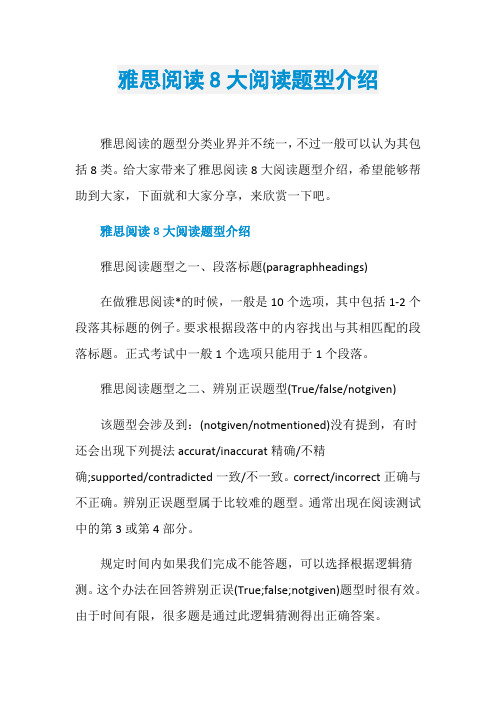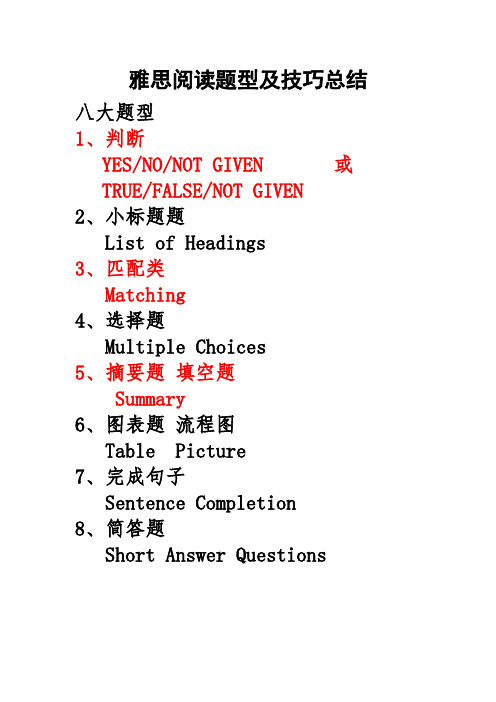雅思阅读代表性8种题目类型解说
雅思阅读8大阅读题型介绍

雅思阅读8大阅读题型介绍雅思阅读的题型分类业界并不统一,不过一般可以认为其包括8类。
给大家带来了雅思阅读8大阅读题型介绍,希望能够帮助到大家,下面就和大家分享,来欣赏一下吧。
雅思阅读8大阅读题型介绍雅思阅读题型之一、段落标题(paragraphheadings)在做雅思阅读*的时候,一般是10个选项,其中包括1-2个段落其标题的例子。
要求根据段落中的内容找出与其相匹配的段落标题。
正式考试中一般1个选项只能用于1个段落。
雅思阅读题型之二、辨别正误题型(True/false/notgiven)该题型会涉及到:(notgiven/notmentioned)没有提到,有时还会出现下列提法accurat/inaccurat精确/不精确;supported/contradicted一致/不一致。
correct/incorrect正确与不正确。
辨别正误题型属于比较难的题型。
通常出现在阅读测试中的第3或第4部分。
规定时间内如果我们完成不能答题,可以选择根据逻辑猜测。
这个办法在回答辨别正误(True;false;notgiven)题型时很有效。
由于时间有限,很多题是通过此逻辑猜测得出正确答案。
雅思阅读题型之三、回答问题(short-answerquestiontasks)回答问题是根据所给*或图表回答问题。
雅思阅读考试中中通常是出现what、which、when、where、who、whose、whom、why、how等单词。
这些单词有时会在答题指引中将所提问题列出。
回答问题答题步骤:1.仔细查看答题指引,了解回答何种问题。
2.查看例句,确定答题方式。
3.要确定问句的种类,一般疑问句可按正常形式回答,如果是选择疑问句或者是以wh/how开头的问句就一定要具体回答。
4.仔细理解问句所提问题。
5.特别要注意问句中所提问题的关键词语(例如:单数、复数),以及问句中表明数量、时间、地点的词语。
6.将问句中的关键词语与*中相关句子中的词语进行匹配。
雅思阅读八大题型之填空题

环球雅思老师为你解读雅思阅读八大题型之判断题雅思阅读主要有以下八大题型:判断题(TURE/FALSE/NOT GIVEN),填空题(SUMMARY),段落标题配对题(LIST OF HEADINGS),配对题(MA TCHING),选择题(MUTILPCHIOCE),填空题(COMPLETION),简答题(SHORT ANSWER)和图表题(TABLE)。
其中前四类题型是雅思阅读的必考题型。
本文主要分析填空题(SUMMARY)的读题和解题技巧。
一、填空题的读题与解题⑴填空题主要分为两类:目前归纳题有两种趋势,一种是题目贯穿在整篇文章,另一种是只隐藏在其中一二个段落。
前者下文称为“有备选项”,后者下文称为“无备选项”。
①“有备选项”的填空题特征:题干内容分布在原文多个段落中,比较零散,找题难度较大;要求考生找出原文原词后,从备选项表格中找出跟原文原词同义置换的选项,解题难度较大。
②“无备选项”的填空题特征:题干内容分布在原文2-3段中,因此要求考生准确定位题干在原文中的出处,然后主意要填写原文原词即可。
⑵读题“四步走”。
①第一步:精读填空题题干的首段首句。
无论有备选项还是无备选项,首句一般不设空,因此通过划找首句的关键词,能够帮助考生会原文准确定位出题方位,避免时间的浪费。
通常,可以作为关键词回原文定位的包括:人名、地名、机构、时间、年代、数字、专有名词。
②第二步:处理第一个空格如果首句模糊或首句设有空格,就要按照以下2步来处理第一个空格:第一,根据空格前后内容初步判断空格词性。
一般填空题的题干词性都是名词、动词、形容词和副词,以前三者为主。
第二,划找“空前空后词”,这里所谓的“空前空后词”不是实际意义上的空前空后词,而是那些能够提示空格内容的词组和结构。
③第三步:继续处理其余空格填空题的出题顺序也是按照原文行文顺序来的,考生按照处理第一个空格的方式继续处理其余空格即可。
即便有逆向出题或是乱序,也是少数,而且也只会是两个近似空格的乱序。
雅思考试阅读部分的8种类型题应答全攻略

雅思考试阅读部分的8种类型题应答全攻略
一、paragraph headings(段落标题)最频繁的题型之一
在阅读文章的后面给出list of headings,一般是10个左右选项,其中含一到两个段落及其标题的例子。
要求对题目中给出的段落,根据其内容找出与其相匹配的段落标题。
尽管题目说明中提示一个选项可能会适用多个,但正式考试中一般一个选项只能用于一个段落。
段落标题类答题步骤:
1. 首先在list of headings中划去做为例子的heading 或headings,以免在根据段落内容在list of headings中找出与其相匹配的段落标题时,它(它们)会干扰考试者对其他headings的选择。
2. 在文章中把做为例子的段落划掉,以免对例子段落进行不必要的精读。
3. 对题目中给出的段落,按照首句(第一、二句)、末句和中间句寻找主题句的方法,在list of headings中找出与其相匹配的段落标题。
4. 如果时间允许,按照文章的段落顺序,对非题目中给出的段落及。
雅思阅读考题类型及解题技巧汇总

雅思阅读考题类型及解题技巧汇总雅思阅读考试时间一共是60分钟,考生需要在此期间完成3篇文章的阅读及回答40道题目。
其中40道题目中,题型各有不同。
店铺总结了在雅思阅读题目中,常见的八种题型,具体如下。
雅思阅读考题类型及解题技巧汇总1.填空题2.选择题3.配对题4.真假题5.完成句子题6.图解标签题7.短问答8.图表完成题对于不同的文章,同学们最好采取不同的应对方式,以提高答题效率及答题准确性。
在此,小站教育就先给大家来讲一讲雅思阅读中的填充题及选择题的解题技巧,正在备考的同学们快快看过来吧。
详解雅思阅读考试填空题通常来说,在雅思阅读考试中的填空题大多是遵循顺序原则,只有极为少数的情况下是前后两个题目顺序打乱了的。
如果填空题出现在一篇文章后的第一个题目,那么往往是考察全篇的题目;以此类推,当填空题出现在文章后面的中间题型,那么对应文章段落也应该为中间部分;当然如果填空题出现在文章最后一个题型,基本上就是对应文章中后部分以及文章最后的段落。
所谓知己知彼,百战不殆。
同学们如果对题型特点有了一个深入的了解后,那么就能有助于同学们更好地把握整篇文章及进行精确定位。
对题型特点有了一个了解之后,再从从题目入手。
小站教育建议大家首先观察题目中围绕空格前后是否有表示句子关系的词,例如表示转折关系的but, 因果关系because, as a result of, 并列关系and, 举例关系for example, such as以及时间关系before等。
所谓细节决定成败,把握这些小细节往往是做题的关键。
即便来说这些关系词在原文中是用其他词做了替换了,但关系依然存在。
怎样对空格里的词进行定位。
小站教育建议大家依据顺序原则,在空格前后划出特殊定位词,以此来帮助定位。
如果说没有特殊定位词,就找相对特殊的名词或者动词来依顺序进行定位。
详解雅思阅读选择题出题方式1.改写原则:出题关键字基本都是对文章内容的改写;2.顺序原则:文中题目基本上按照文章顺序排列;3.首尾原则:大约50%的题目分布在文章首尾句以及首尾段;4.名词原则:出题关键字基本都以名词作为考点;5.数字原则:会出现一些带有简单运算最难不超过四则运算的简答题;6.下定义原则:破折号,同位语从句,定语从句有可能处提;7.特殊符号,特殊字体原则:括号(),引号“”,黑体,斜体,下划线,以及比较罕见的词汇有可能出题;8.图表原则:如果文章中有图表则要留心图表部分会出题。
雅思阅读题型及技巧总结

雅思阅读题型及技巧总结八大题型1、判断YES/NO/NOT GIVEN 或TRUE/FALSE/NOT GIVEN2、小标题题List of Headings3、匹配类Matching4、选择题Multiple Choices5、摘要题填空题Summary6、图表题流程图Table Picture7、完成句子Sentence Completion8、简答题Short Answer Questions一、Matching①、专有名词类(大写类)②、图形类③、小写类④、段落信息匹配类⑤、分类类(一)、专有名词类(大写类)1、题型识别:总有一组含有人名/地名/机构名2、解题方法①、返回原文,圈出大写,阅而不读②、阅读另一选项组较短:具有定位功能较长:划出定位词③、利用复现原则解题原词复现同义复现(同义替换)语义复现④、阅读圈出大写前后内容(向上,向下均不超过两句话)与另一选项组匹配得出答案3、注意①、若题干中出现N.B.则必然会有选项被重复使用若题干中没有N.B.则必然没有选项被重复使用②、若选项中有all of the above; none of the above;both *** and *** 则该选项必然会用到当且仅当一次(二)、图形类1、题型识别一组图形,一组描述2、解题方法与大写类相似,但是重点考察文字与图形、数字之间的关系3、补充:表形状的词汇triangle 三角形triangular 三角形的rectangle 矩形rectangular 矩形的polygon 多角形polygonal 多角形的pentagon 五角形pentagonal 五角形的hexagon 六角形hexagonal 六角形的octagon 八边形octagonal 八边形的Square 正方形arc 弧,弓形,拱Diamond 菱形cross 十字形Sphere 球体spiral 螺旋形的Cylinder 圆柱体cone 锥形体Pyramid 棱锥cube 立方体Crescent 月牙形oval 椭圆的Heart 心形curve 曲线wavy 波状的dash 虚线Diameter 直径radius 半径perimeter 周长(三)、小写类1、题型识别两组都是由普通名词组成2、解题方法与大写类相似,要点是把握题目中不能同义替换的词或短语3、注意题目要求填选项还是选项前的代表字母(四)、段落信息匹配类1、题型识别Which paragraph contains the followinginformation?且只有一个选项组2、选项特点①、核心词 + 限制部分②、名词 + 介词短语③、名词 + 分词状语④、名词 + 定语分句3、解题步骤①、一次性完成所有题目限制部分中核心定位词的判断 (尽量少)②、顺序,分节进行全文查读(五)、分类类1、题型识别Classify the following …2、选项特点题干 = 固定信息+可变信息3、解题方法①、对分类信息组中的固定信息进行定位②、定位区域较小,进行局部阅读③、将阅读结果与题目信息组比较得出判断④、如定位区域较大或同一固定信息多次重复,则一次性记忆所有题目核心定位词,再按顺序分节阅读⑤、将阅读结果与题目信息比较得出判断⑥、若存在可变信息,在判断时注意定位区域交集或主/客观表达二、Summary①、选词②、填词解题步骤1、确定summary在文章中的位置①、阅读首句②、读题目要求2、确定空格所要填的词的词性3、根据每个空格所在句子的关键词返回原文进行定位4、在原文该句中找出符合该空格的语法5、如何精确定位①、若V.+N. 应定位动词②、若V.+Prep. +N. 应定位介词③、若V.+Prep.+N.+空格后成分用介词或空格后成分定位④、若adj.+n. 用离名词最近的形容词定位⑤、主动与被动S. +V. (主) +O.+V. (被) +by S.注意冠词以及介词不作为词数的限制之内,但必须写在空格内并用“()”括起来三、TRUE/FALSE/NOT GIVEN(YES/NO/NOT GIVEN)1、解题方法①、找出定位词②、找出考点词题目的谓语或表语是考点词。
雅思a类阅读8种主要题型技巧总结

雅思a类阅读8种主要题型技巧总结雅思考试的阅读部分是很多考生的短板,其中A类题型涉及范围比较广,需要考生在短时间内做出正确的选择。
下面是8种主要题型的技巧总结:1. 主旨题主旨题是针对文章主要思想的问题,考生需要准确理解文章的重点和主旨。
通常主旨题会出现在文章的开头或结尾,或是通过多次提及来暗示主题。
2. 细节题细节题是考察考生对文章中细节信息的捕捉能力,通常考生需要在文章中找到具体的词语、数字或日期等细节信息,然后将其填入题目空格中。
3. 推断题推断题是考察考生对文章意义和文章中隐含信息的理解能力,需要结合文章上下文来推断答案。
通常考生需要运用逻辑推理能力来解答此类题目。
4. 对比题对比题是考察考生对文章中两个或多个事物之间相同和不同之处的辨析能力。
考生需要准确找出文章中的比较对象,并对它们进行对比分析。
5. 事实题事实题是考察考生对文章事实信息的理解能力,通常问题的答案可以在文章中直接找到。
考生需要注意细节信息,准确找出文中的事实细节,然后进行选择题。
6. 句意题句意题是考察考生对文章中句子意思的理解能力,通常需要考生通过上下文来推断句子的意思。
考生需要注意文章中的语法结构和修辞手法,来理解句子的真正含义。
7. 排序题排序题是考察考生对文章中事件发生顺序的理解能力,通常需要考生通过细节信息分析出故事情节,并将其排序。
考生需要注意故事中的时间和顺序关系,准确排序。
8. 否定题否定题是考察考生对文章信息的准确性判断能力,通常需要考生通过对文章内容进行分析,找出错误或不真实的信息。
考生需要仔细阅读文章,准确找出不符合事实的信息,进行排除。
以上是雅思A类阅读8种主要题型的技巧总结,希望可以对考生们在备考中有所帮助。
剑桥雅思 阅读 分类

剑桥雅思阅读分类1. 主旨题主旨题是雅思阅读中常见的一种题型,要求考生从整个文章的内容中找出一个准确的总结。
剑桥雅思阅读中的主旨题多以文章的标题或开头段落提供的线索为基础,通过理解文章的中心思想得出正确答案。
主旨题的解答通常需要理解整个文章的逻辑结构、段落之间的关系以及作者的写作意图。
2. 细节题细节题是考察考生对文章细节信息的理解和掌握程度的一类题型。
在剑桥雅思阅读材料中,细节题通常要求考生通过阅读文章,从中定位出某个具体信息,并根据所给的选项进行匹配。
细节题的解答需要考生具备较强的阅读理解能力,能够快速准确地找到相关信息,并做出正确判断。
3. 推理题推理题是考察考生对文章逻辑推理能力的题型。
在剑桥雅思阅读中,推理题常常要求考生通过阅读文章,根据所给的信息进行推理或推断。
这类题目通常需要考生全面了解文章中的信息,然后做出合理的推理。
解答推理题需要考生善于分析和猜测作者的意图,理解文章的逻辑关系。
4. 配对题配对题是考察考生查找信息匹配关系能力的题型。
在剑桥雅思阅读中,配对题可能是匹配段落与摘要,匹配人物与观点,匹配标题与段落等。
这类题目要求考生通过阅读文章和题目,找到相关的信息进行匹配。
配对题的解答需要考生有较强的信息匹配能力和对文章结构的整体把握能力。
5. 填空题填空题是对考生本文填写词语、短语或句子的题目。
剑桥雅思阅读中的填空题设计灵活多变,有些是通过文章的段落描述找到答案,有些是通过整个文章的内容推测答案。
填空题的解答需要考生能够准确理解文章的信息,并在不影响文章逻辑的情况下填写正确的答案。
总结剑桥雅思阅读材料类型多样,包括了主旨题、细节题、推理题、配对题和填空题等不同类型的题目。
在备考雅思阅读时,考生需要充分理解和掌握每种题型的解题思路和技巧,通过大量练习提高阅读能力和解题能力,以取得较好的成绩。
八种雅思阅读题目解题全攻略

八种雅思阅读题目解题全攻略一、List of Headings (标题对应题) 标题对应题在文章后面给出的段落标题一般是10 个选项,其中含一到两个段落及其标题的例子。
要求对题目中给出的段落,依据其内容找出与其相匹配的段落标题。
尽管题目说明中提示一个选项可能会适用多个但中国考区考试中一般一个选项只能用于一个段落。
考生应首先在list of Headings 中划去做为例子的heading或headings,以免在依据段落内容在list of Headings 中找出与其相匹配的段落标题时,它〔它们〕会干扰考试者对其他headings 的选择。
同时在文章中把做为例子的段落划掉,以免对例子段落进行不必要的精读。
在解答标题对应题目时,考生应对一些可以利用来直接选出答案的词汇加以特别留意。
比方:假如一个标题中消失了definition 这个词,那么这个标题很有可能就对应文章的第一段,由于在写文章的.时候,想要引入某一概念时,往往会在第一段就对这个概念下定义。
又比方:假如在一个标题中消失了salary, wage等词,那么考生可以到文章中查找一个含有较多货币符号的段落。
当然象这样的窍门还有许多,考生可以在预备雅思学术类阅读考试的过程中不断摸索。
对于大部分题目,特殊是较难的标题对应题目来说还是要遵循上文所述的基本解题方法来做题的,有时甚至要通读全文.二 MATCHING〔配对题〕这种题型是雅思学术类阅读考试中比较普遍的题型,也是相对而言较为耗费时间和精力的一种题型。
配对题主要包含以下几种形式:文章中的重要概念和对这个概念的阐释配对;学者及其主要观点相配;错误观点〔misconception〕和反对错误观点的论据〔counterargument〕相配;大事和大事的进展过程相配;原因和结果相配;某种标志性事物和其所在的时代相配;新产品和创造家、创造时间等相配。
尽管针对不同题目可以有一些解题窍门,但对于大多数配对题来说,答题步骤都是固定而且枯燥的:考生应当首先认真查看答题指引,了解回答何种问题。
- 1、下载文档前请自行甄别文档内容的完整性,平台不提供额外的编辑、内容补充、找答案等附加服务。
- 2、"仅部分预览"的文档,不可在线预览部分如存在完整性等问题,可反馈申请退款(可完整预览的文档不适用该条件!)。
- 3、如文档侵犯您的权益,请联系客服反馈,我们会尽快为您处理(人工客服工作时间:9:00-18:30)。
雅思阅读代表性8种题目类型解说雅思阅读代表性8种题目类型解说一文向我们介绍了雅思阅读中典型的8种题型的出题方式和考点。
这8类题型虽然名字大家都熟知,但是要真正掌握他们的技巧,还是需要一定努力的。
雅思阅读代表性8种题目类型解说雅思阅读代表性8种题目类型解说为你带来在雅思阅读中具有代表性的8种类型的题目的解说。
在雅思阅读中,出现过的题型应该有14、15种之多,其中经常用来考察的题型又有10种左右。
今天我们介绍的是这10种当中最具代表性的8种,同学们可以在制定雅思阅读备考计划之前对这些考察题型进行了解。
雅思阅读题型一、paragraph headings(段落标题)最频繁的题型之一一般来说有10个左右的标题选项会给出在阅读*的后面,其中会包含一到两个段落和其标题的例子。
这种题目要求考生对给出的段落在*内容中找出与其相匹配的段落标题,虽然题目给出的标题会应用于多个段落,但是在正式的考试中,一个选项只能适用于一个段落。
雅思阅读题型二、辨别正误题型(True / false /not given)该题型还涉及到:(not given / not mentioned)没有提到,有时还会出现下列提法accurat / inaccurat 精确/不精确;supported / contradicted 一致/不一致。
correct / incorrect 正确与不正确。
辨别正误题型属于难度较大的题型。
通常在阅读测试中的第三或第四部分出现。
雅思阅读题型三、回答问题(short-answer question tasks)回答问题是根据所给*或图表回答问题。
这种题目是考察考生对信息的筛选和提取能力,比如在IELTS阅读测试中通常是用下列单词提问:. what、which、when、where、who、whose、whom、why、how 等。
除了利用上述单词进行提问外,有时会在答题指引中将所提问题列出。
雅思阅读题型四、完成图表、示意图题型(table、chart or diagram completion)这种题目就是要求考生将图标的信息补全。
在雅思阅读中,会出现很多的图表和示意图,这些图表中的文字内容不多,但是问题的答案都包含在图表之中,需要考生自己去填补。
雅思阅读题型五、配对题(matching)这种题型也是考察考生的信息筛选能力。
这种题型较为普遍,配对的范围主要包括新产品的发明家、发明时间,事件和事件的发展经过,事件发生的原因和结果,*内容中概念的解释和标志性事物及其所处的年代等等。
雅思阅读题型六、摘要(summary)、填空题型(gapfill)填空题通常有两种形式:一种是根据*内容选择词或短语填空,一般是为阅读*的缩写内容进行填空;另一种则无参考*,只是一篇短文。
第一种题型相对第二种题型较难,所花费时间较多,因为要将两篇*进行语句、词语的比较。
不过这种缩写形式对于理解所给阅读*有所帮助。
第二种形式是利用所给单词或短语进行填空。
上述两种形式填空题都需要借助语法、词法知识,分析所需填空*中相关句子的含义。
雅思阅读题型七、完成句子题型(sentence completion tasks) 这种题目比较花时间,需要考生根据选项在*仔细的寻找相关的信息,这也是考察考生筛选信息和提取信息的能力。
题目会给出句子的一部分内容,没有给出的部分就要求考生在*中去找,或者给你选项让你选一个。
雅思阅读题型八、多重选择题型(maltiple-choice tasks)IELTS阅读测试中多重选择题型与toefl测试中的多重选择题型虽然类似,但实质上差别很大。
ielt阅读测试中的多重选择题型更多侧重于对*的理解,而非强调语法、词法的运用。
以上就是雅思阅读代表性8种题目类型解说的全部内容,同学们都看懂每一种考题的出题思路和考察点了吗。
对雅思阅读的各种题型进行了解是我们在进行备考时必须要做到的事情,不然的话,光是凭借整套地练习雅思阅读题而不进行同类题型的解题方法和思路的总结提升的话,是很难在规定时间内做完雅思阅读40多道题的。
雅思考试阅读模拟试题Sleep medication linked to bizarre behaviourNew evidence has linked a commonly prescribed sleep medication with bizarre behaviours, including a case in which a woman painted her front door in her sleep.UK and Australian health agencies have released information about 240 cases of odd occurrences, including sleepwalking, amnesia and hallucinations among people taking the drug zolpidem.While doctors say that zolpidem can offer much-needed relief for people with sleep disorders, they caution that these newly reported cases should prompt a closer look at its possible side effects.Zolpidem, sold under the brand names Ambien, Stilnoct and Stilnox, is widely prescribed to treat insomnia and other disorders such as sleep apnea. Various forms of the drug, made by French pharmaceutical giant Sanofi-Aventis, were prescribed 674,500 times in 2005 in the UK.A newly published report from Australia’s Federal Heal th Department describes 104 cases of hallucinations and 62 cases of amnesia experienced by people taking zolpidem since marketing of the drug began there in 2000. The health department report also mentioned 16 cases of strangesleepwalking by people taking the medication.Midnight snackIn one of these sleepwalking cases a patient woke with a paintbrush in her hand after painting the front door to her house. Another case involved a woman who gained 23 kilograms over seven months while taking zolpidem. “It was only when she was discovered in front of an open refrigerator while asleep that the problem was resolved,” according to the report.The UK’s Medicines and Healthcare products Regulatory Agency, meanwhile, has recorded 68 cases of adverse reactions to zolpidem from 2001 to 2005.The newly reported cases in the UK and Australia add to a growing list of bizarre sleepwalking episodes linked to the drug in other countries, including reports of people sleep-driving while on the medication. In one case, a transatlantic flight had to be diverted after a passenger caused havoc after taking zolpidem.Hypnotic effectsThere is no biological pathway that has been proven to connect zolpidem with these behaviours. The drug is a benzodiazepine-like hypnotic that promotes deep sleep by interacting with brain receptors for a chemical calledgamma-aminobutyric acid. While parts of the brain become less active during deep sleep, the body can still move, making sleepwalking a possibility.The product information for prescribers advises that psychiatric adverse effects, including hallucinations, sleepwalking and nightmares, are more likely in the elderly, and treatment should be stopped if they occur.Patient advocacy groups say they would like government health agencies and drug companies to take a closer look at the possible risks associated with sleep medicines. They stress thatstrange sleepwalking and sleep-driving behaviours can have risky consequences.“When people do something in which they’re not in f ull control it’s always a danger,” says Vera Sharav of the NewYork-based Alliance for Human Research Protection, a US network that advocates responsible and ethical medical research practices.Tried and tested“The more reports that come out about the potential side effects of the drug, the more research needs to be done to understand if these are real side effects,” says sleep researcher Kenneth Wright at the University of Colorado in Boulder, US.Millions of people have taken the drug without experiencing any strange side effects, points out Richard Millman at Brown Medical School, director of the Sleep Disorders Center of Lifespan Hospitals in Providence, Rhode Island, US. He says that unlike older types of sleep medications, zolpidem does not carry as great a risk of addiction.And Wright notes that some of the reports of “sleep-driving” linked to zolpidem can be easily explained: some patients have wrongly taken the drug right before leaving work in hopes that themedicine will kick in by the time they reach home. Doctors stress that the medication should be taken just before going to bed.The US Food Drug Administration says it is continuing to "actively investigate" and collect information about cases linking zolpidem to unusual side effects.The Ambien label currently lists strange behaviour as a “special concern” for people taking the drug. “It’s a possible rare adverse event,” says Sanofi-Aventis spokesperson Melissa Feltmann, adding that the strange sleepwalking behaviours “may not neces sarily be caused by the drug” but instead result from an underlying disorder. She says that “the safety profile [of zolpidem] is well established”. The drug received approval in the US in 1993.雅思考试阅读模拟试题及答案解析Questions 1-6Do the following statements agree with the information given in the reading passage?In boxes 1-6 on your answer sheet writeTRUE if the statement is true according to the passageFALSE if the statement is false according to the passageNOT GIVEN if the information is not given in the passage。
